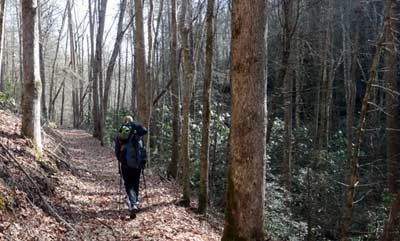
Christine Hoyer Photo Trees and Limbs: Before you set up camp, take a moment to look up and around you for any trees or limbs that may pose a hazard. Camp away from any areas that may be threatened by tree or limb fall. Wind: High winds associated with approaching weather fronts can bring down trees and limbs. Wind can also decrease your ability to keep warm. Stream Crossings and Waterfalls:
3. Scout the stream bank for the best location to cross. The best location may not be where the trail comes into the stream. 4. Often the most narrow point of the stream is not the best place to cross as water flows more quickly in that area. 5. Undo the chest strap and hip belt of your pack before crossing any stream. If you fall in, you can quickly escape from your pack. Otherwise, the weight of the pack can help drag you downstream or pull you under water. 6. Wear shoes to protect your feet. Many hikers bring water sandals or shoes for creek crossings. 7. Use hiking poles or stout sticks to help you get across. 8. Most stream rocks in the Smokies are extremely slippery. 9. If you lose your footing, float with your feet downstream to protect your head and upper body. 10. Many rain swollen streams in the Smokies are too dangerous to cross. If in doubt, don't do it! 11. Never camp next to a rain swollen stream and never camp next to a stream during heavy rain. Flash floods are common and can easily sweep away equipment and people. 12. Never climb on waterfalls. There have been many fatalities in the park from doing so.
|
Last updated: April 14, 2015
